Roller Shutter
measuring guide
Measuring Roller Shutters has never been this easy
Hello and welcome to our straightforward manual on measuring your windows for your upcoming roller shutters. You’ll be pleasantly surprised at how simple and speedy it is to complete the measurements, so let’s get started!
Tools you’ll need
- A steel tape measure
- A pencil and paper to record measurements
Prior to measuring your window, it is important to choose between two options:
1. Operating system
Prior to commencing the measuring process, a major factor that needs to be considered is the type of operating system, which may be manual, battery-powered, or electric.
2. Mounting methods
Another important factor that needs to be considered, is to determine the appropriate mounting method for your window, whether it is in a reveal/recess or on the wall.
Choose your operating system
Manual Roller Shutter
Electric & Battery Roller Shutter
Manual Roller Shutters
Measuring wall mounted
Using a wall mounting method is the simplest and easiest method for DIY installation.
However, a manual control winder is the hardest of all installations.
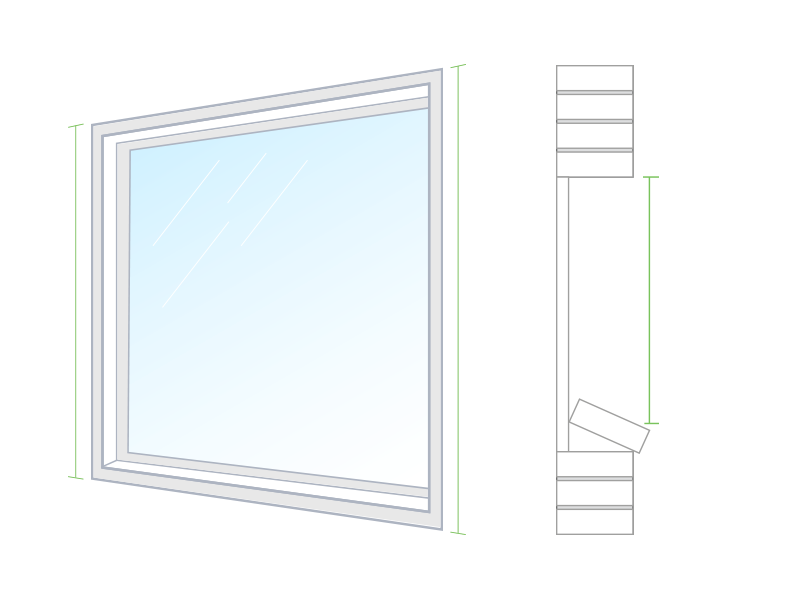
wall mounted
DIY Roller Shutter height measurement
To measure the height of the roller shutter you simply need to take two measurements – one on the left side of the window and one on the right side of the window.
Measure the height from the top of the window opening down to the bottom of the window opening or sill.
wall mounted
Protruding window height
If your window frames or architraves protrude out past the wall, then measure the height from the top of the architrave to the bottom of the frame/architrave.
If your window frames or any part of the window protrudes out past the wall you will need to use packers when installing.
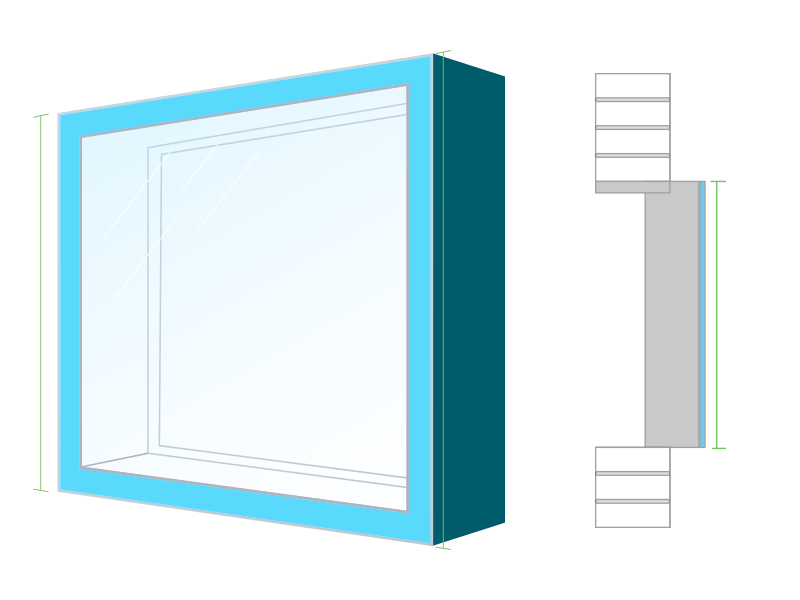

wall mounted
Protruding window height
If your window frames or architraves protrude out past the wall, then measure the height from the top of the architrave to the bottom of the frame/architrave.
If your window frames or any part of the window protrudes out past the wall you will need to use packers when installing.
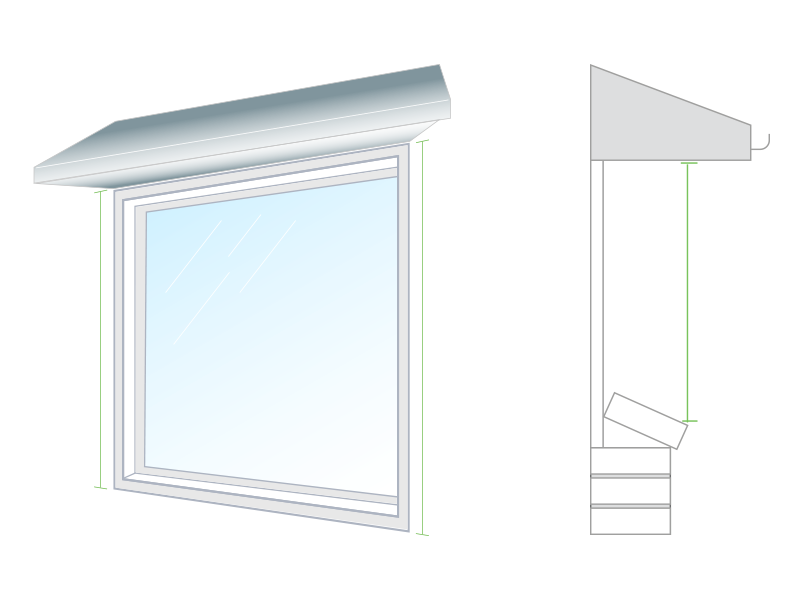
wall mounted
Window directly underneath the eaves
If your window is located directly underneath the eaves, measure from the bottom of the eaves to the sill to get your height measurement.
Always measure to the nearest mm. If your two measurements differ do not worry always use the larger of the two measurements.
From the largest of the two measurements deduct 50mm and write that down this is the curtain height.
(NB. The bottom of the header box on a manual winder installation needs to sit 50mm below the top of the opening of the window which is why we deduct 50mm from the measurements.)
Now we need to select an appropriate header box for your chosen shutter type.
Simply look up your curtain height (largest height measurement less 50mm) below and select the header box.
Domestic Shutters
Curtain height
Up to 1300
Up to 1700
Up to 2100
Up to 3000
Header box size needed
150mm
165mm
180mm
205mm
Total max height inc. header
1700mm
2135mm
3000mm
3800mm
wall mounted
DIY Roller Shutter width measurement
Measure the width of the window at the bottom and the width at the top, and use the widest measurement. You then add the width of the guide rails to that measurement. The width of the guides is 53mm and there are two guides, so 106mm is added to the width of the window.
E.g. window width 1500mm plus 106mm equals 1606mm, this would be the overall width for ordering.
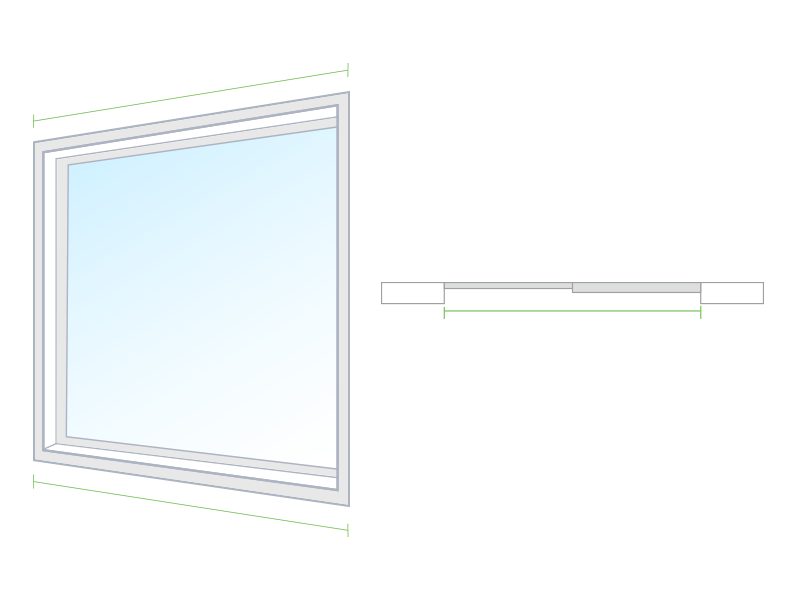

wall mounted
DIY Roller Shutter width measurement
Measure the width of the window at the bottom and the width at the top, and use the widest measurement. You then add the width of the guide rails to that measurement. The width of the guides is 53mm and there are two guides, so 106mm is added to the width of the window.
E.g. window width 1500mm plus 106mm equals 1606mm, this would be the overall width for ordering.
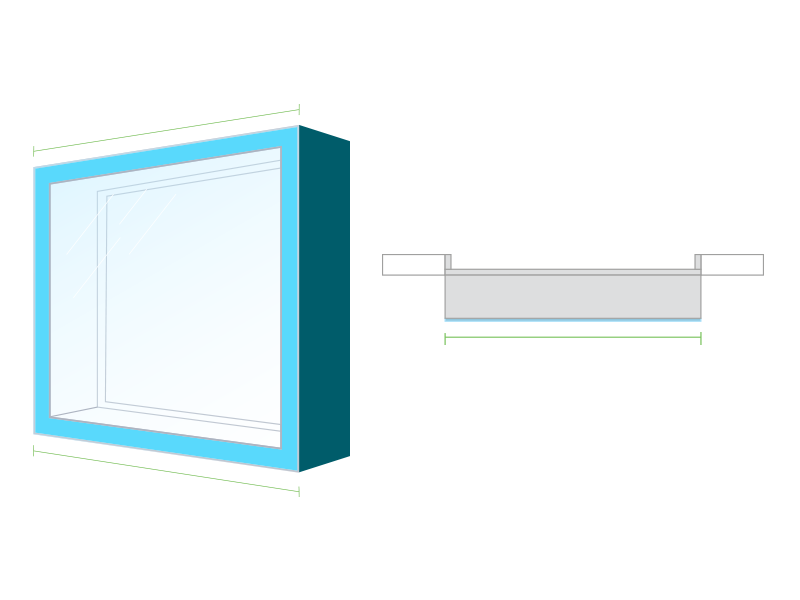
wall mounted
Protruding window width
If your window frames or architraves protrude out past the wall, then measure the width from the left-hand edge of the architrave to the right-hand edge of the architrave.
Don’t worry if the two measurements differ simply use the larger of the two measurements. If your window frames or architraves protrude out passed the wall, then you will need to use packers when installing.
Manual Roller Shutters
Measuring in reveal
In reveal installation is the hardest installation type. In reveal allows for NO margin for error, and is only suitable for homes with a double wall and cavity construction. In-reveal installation does not suit windows that open outward and will restrict windows from opening.
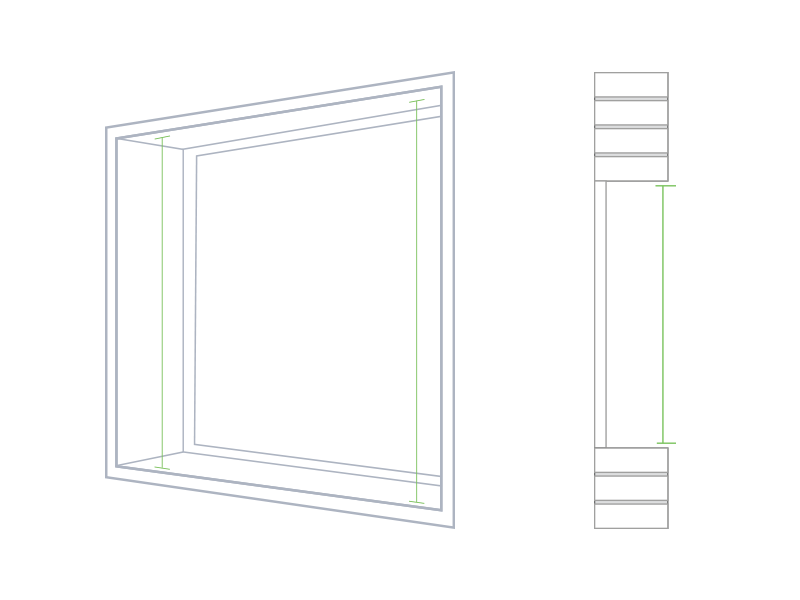
in reveal
DIY Roller Shutter height measurement
Measure both sides of the window and always use the largest of the two sides.
If the window does not go all the way to the eave, measure from the sill to the top of the window opening and this overall height measurement also includes the correct box size automatically. When installing the roller shutter will be installed back 40mm into the reveal, reducing the size of the guides, this allows you to cut the guide to the exact length, and sill angle when installing.
in reveal
Window directly underneath the eaves
Measure both sides of the window and always use the largest of the two sides. If the window goes all the way up to the eave, measure from the eave to the sill, this overall height measurement already includes the correct head box size.
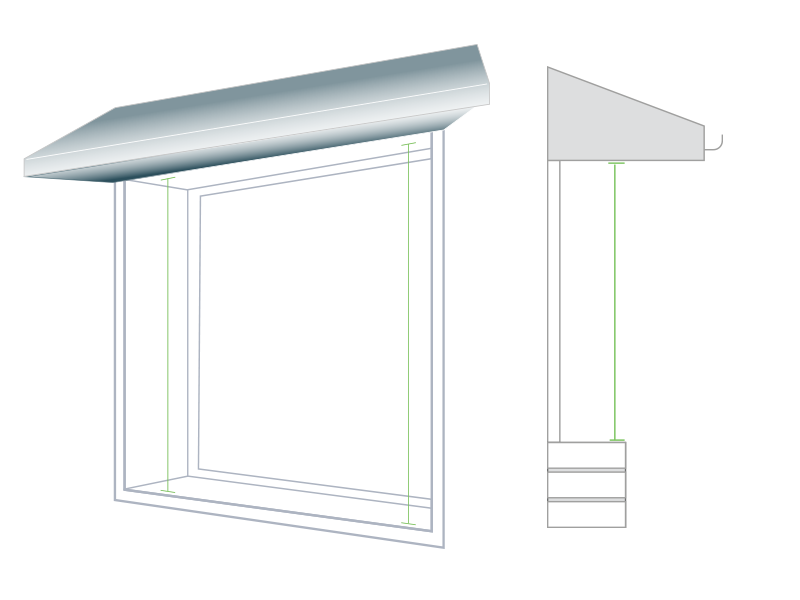

in reveal
Window directly underneath the eaves
Measure both sides of the window and always use the largest of the two sides. If the window goes all the way up to the eave, measure from the eave to the sill, this overall height measurement already includes the correct head box size.
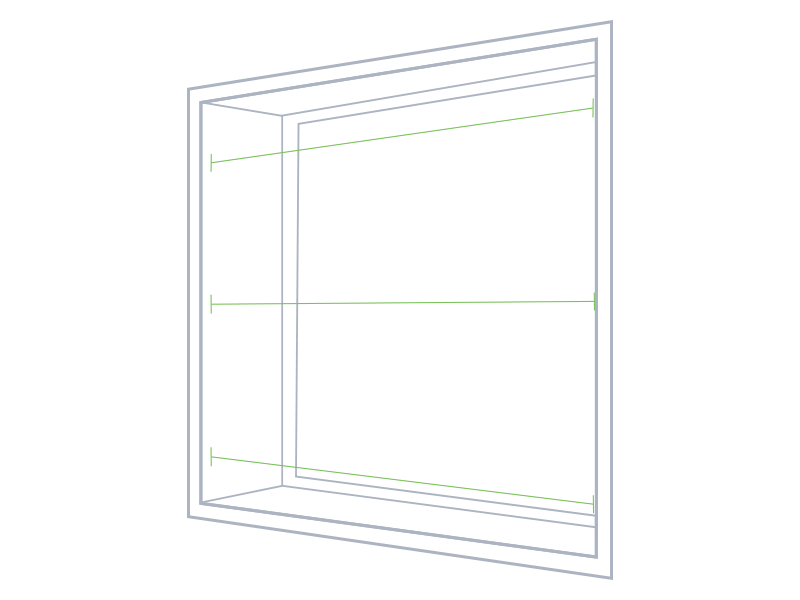
in reveal
Width measurement
To determine the width of the window measure the window at the top at the bottom, and also in the middle, and ALWAYS use the smallest measurement. If the smallest width is at the top, where the head box is to be installed, reduce the width by 3mm to ensure that the headbox fits in the reveal of the window. This is your overall width for ordering.
Electric & Battery roller shutter
Measuring wall mounted
A battery-operated Roller Shutter is one of the easiest DIY projects. It does not require an electrician, unlike an electric shutter.

wall mounted
DIY Roller Shutter height measurement
Always make sure you measure both sides of the window and ALWAYS use the larger of the two sides. There are two ways the roller shutters can be installed, either on the wall or in reveal. On the wall is far more accepting of out-of-square windows.
It’s completely optional where the head box sits with OW installation, can be right up under the eave, or right above the lintel it can even be halfway under the lintel or anywhere in between.
The overall height of the roller shutter is from the top of the head box, so use the table below to work out the overall size of the roller shutter.
Domestic Shutters
Battery motor will fit in the 165mm/180mm and 205mm box heads.
Curtain height
Up to 1300
Up to 1700
Up to 2100
Up to 3000
Header box size needed
150mm
165mm
180mm
205mm
Total max height inc. header
1700mm
2135mm
3000mm
3800mm
wall mounted
DIY Roller Shutter width measurement
Measure both sides of the window and ALWAYS use the largest of the two measurements.
The guide rails of the roller shutter are 53mm each, each roller shutter of course has two guide rails, so that’s 106mm that has to be added to the width of the window. The width of the window plus 106mm equals the ordering width.


wall mounted
DIY Roller Shutter width measurement
Measure both sides of the window and ALWAYS use the largest of the two measurements.
The guide rails of the roller shutter are 53mm each, each roller shutter of course has two guide rails, so that’s 106mm that has to be added to the width of the window. The width of the window plus 106mm equals the ordering width.
Electric & Battery roller shutter
Measuring in reveal
In reveal measurements have to be very precise, NO MARGIN FOR ERROR!
Measure from the sill to the top of the window opening (lintel).

in reveal
DIY Roller Shutter height measurement
In reveal measurements have to be very precise, NO MARGIN FOR ERROR! Measure from the sill to the top of the window opening (lintel).
in reveal
Width measurement
IR installation once again has to be precise, NO MARGIN FOR ERROR! Measure the window at the top, at the bottom, and in the middle. ALWAYS use the smallest measurement, if the smallest measurement is at the top of the window where the head box is to go, subtract 3mm from your overall width.
E.g. overall width is 1500mm taking the smallest measurement from the top of the window, the new measurement will be 1497mm. If the smallest measurement was taken from the bottom, the overall width would stay at 1500mm.


in reveal
Width measurement
IR installation once again has to be precise, NO MARGIN FOR ERROR! Measure the window at the top, at the bottom, and in the middle. ALWAYS use the smallest measurement, if the smallest measurement is at the top of the window where the head box is to go, subtract 3mm from your overall width.
E.g. overall width is 1500mm taking the smallest measurement from the top of the window, the new measurement will be 1497mm. If the smallest measurement was taken from the bottom, the overall width would stay at 1500mm.
If your windows open outward, e.g. hopper windows or casement windows in reveal installation may stop your windows from opening. Remember the guide rails are 53mm wide so on-wall installation would be your best option.
Next Step
Now that you know how to take the measurements of your window, let’s move on to the installation process.
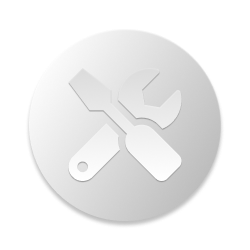
Installation guide
If you still have any questions, please give us a call or send us a message
Frequently Asked Questions
Roller Shutters
What are roller shutters?
Roller shutters are a type of window or door covering that consists of horizontal slats or panels hinged together. These slats are typically made of aluminium or steel, although other materials like PVC or wood may also be used. The shutters are mounted above the window or door opening and can be manually or motor-operated.
What are the advantages of roller shutters?
Overall, roller shutters offer a range of advantages for your home, including enhanced security, privacy, light and noise control, energy efficiency, weather protection, and ease of maintenance. They can be a valuable addition to any property, providing numerous benefits to you and your loved ones.
Can roller shutters make a room completely dark?
Roller shutters can significantly reduce the amount of light entering a room. Keep in mind that the darkness level will depend on various factors like the material and design of the shutters, the installation method, and if there are any gaps or light leaks around the edges.
Are roller shutters secure?
Nowadays roller shutters are considered one of the most secure options for windows and door coverings. That’s because of the extra layer of protection that makes it more difficult for intruders to gain access to your home or commercial property.
However, to keep your home safe with roller shutters, we always suggest ensuring proper installation, regular maintenance, and use of other security measures in combination with security roller shutters, such as alarms, motion sensors, and reinforced entry points, to enhance the overall security of your property.
Do roller shutters provide insulation for your home?
Yes, roller shutters can provide insulation for your home and contribute to energy efficiency as they act as an additional insulating layer on windows and doors. In fact, in colder seasons, roller shutters can help retain heat inside the house, while in hot weather, they can block out heat from entering.
By investing in high-quality roller shutters from shutters4u, you can boost their insulation properties and enjoy the benefits of improved energy efficiency and indoor comfort.
How to clean roller shutters at home?
Cleaning roller shutters at home is an easy process. All you need to do is to wash them with soft soap and scrub them with a sponge or microfibre cloth. Before that, ensure the shutters are closed to clean their interior and exterior. Also, first, remove any debris or dust from their surface.
Remember, regular cleaning and maintenance of roller shutters will help keep them in good condition and prolong their lifespan.
Where can be roller shutters installed?
The versatility and customizable nature of roller shutters make them suitable for various applications, and they can be tailored to fit your specific needs and requirements. Just to mention some examples, roller shutters are usually installed in windows, doors, shopfronts, warehouses, industrial buildings and more.
What roller shutter colours are available in shutters4u?
We have a brilliant colour palette available for shutters in Australia, starting from the classics to the ones that deck up pretty well with your space. Our team also offers customization in terms of colours and brings different combinations for your home or business space. You name it, and we provide it.
If you need ideas for what colours will match your home then give us a call, and we will be happy to suggest the best colour options for you.
How to install DIY roller shutters?
Installation instructions for your DIY roller shutters are available in a detailed step-by-step video as soon as your order is placed. In your order, you will receive a link to a set of videos with instructions on how to install your shutters.
We have a separate video for motorised and manual roller shutter installation, so no matter what you choose you have everything you need to be able to install the shutters yourself with no issues.
Still not sure if DIY Roller Shutters are for you?
We got you covered! We can suggest a group of experienced roller shutter installers who can complete the job for you, ensuring a high-quality finish at great prices. They offer roller shutters in Adelaide, roller shutters in Perth, roller shutters in Sydney, roller shutters in Brisbane and more.
Roller Blinds
What are roller blinds?
Roller blinds are a type of window covering made from a single piece of fabric or other flexible material that can be rolled up or down to cover or uncover a window. They are commonly used in residential and commercial spaces to control the amount of light entering a room and provide privacy.
Roller blinds are known for their simplicity, functionality, and versatility.
They are easy to install and operate, making them a popular choice for window coverings in homes, offices, and other spaces. They provide a clean and streamlined look when fully rolled up and can be adjusted to different positions to allow for varying levels of light and privacy.
What are dual roller blinds?
Double roller blinds are popular for their versatility, offering a practical and stylish solution for controlling light and privacy in residential and commercial spaces. They are a type of window covering that combines two different types of fabrics on a single roller system. They offer the ability to switch between two different levels of light control and privacy, providing versatile functionality and aesthetic options.
What are the benefits of DIY roller blinds?
One of the primary advantages of DIY roller blinds is the potential for cost savings, you can avoid paying for professional installation or custom-made blinds, which can be more expensive. Additionally, they allow you to have full control over the design and customization according to your specific window measurements.
Moreover, an additional benefit of DIY roller blinds is that they are easy to keep clean and maintain.
Fabric options for roller blinds
Depending on the needs you have for each room, there are different fabric options for roller blinds DIY:
- Polyester
- PVC
- Vinyl
Operating system options for roller blinds?
Roller blinds can be operated using various systems, depending on your preferences and requirements. Here are some common operating systems for DIY roller blinds for windows:
- Manual Chain or Cord: This is the most traditional operating system for roller blinds. It involves a chain or cord attached to the blind that allows you to pull up or down the blind to your desired position.
- Spring-Loaded Mechanism: Spring-loaded roller blinds utilize a spring mechanism within the roller tube. These blinds can be easily operated by gently pulling down on the bottom of the blind to lower it and releasing it to allow the spring to retract and raise the blind. This system does not require chains or cords, providing a clean and elegant look.
- Automated: Motorised roller blinds have a motor that allows you to control the blinds using a remote control, wall switch, or even a smartphone app. Motorized blinds are particularly beneficial for hard-to-reach windows or for individuals with mobility issues.
- Smart Home Integration: Some roller blinds can be integrated into smart home systems, such as Amazon Alexa, Google Home, or Apple HomeKit. This allows you to control the blinds using voice commands or through smartphone apps.
Do roller blinds provide insulation for your home?
Roller blinds can provide some level of insulation for your home, depending on the type of fabric or material used. In fact, roller blinds can contribute to energy efficiency and temperature control. During hot weather, using roller blinds with light-coloured or reflective fabrics can help reflect sunlight and reduce solar heat gain, keeping your space cooler. In colder months, using roller blinds made from thicker or insulating materials can help prevent heat loss and improve thermal efficiency.
How to clean roller blinds?
It is important to clean and maintain the roller blinds regularly to ensure they will last for longer.
In this case, there are two easy ways to clean internal roller blinds, either by wiping them down with a damp, soft cloth or vacuuming them.
Where can Roller blinds be installed?
DIY roller blinds can be installed in any residential and commercial space where you have good ventilation. Roller blinds offer a versatile and space-saving solution for controlling light, privacy, and temperature in any room.
However, It's important to consider the specific requirements of the installation location, such as the size of the windows or doors, the mounting options available, and any special considerations for the type of blind chosen.
How to install roller blinds?
Installation instructions for your DIY roller blinds are available in a detailed step-by-step video as soon as your order is placed. In your order, you will receive a link to a set of videos with instructions on how to install your shutters.
We have a separate video for motorised and manual roller blinds installation, so no matter what you choose you have everything you need to be able to install the shutters yourself with no issues.
Still not sure if DIY Roller Blinds are for you?
We got you covered! We can suggest a group of experienced roller blind installers who can complete the job for you, ensuring a high-quality finish at great prices. They offer roller blinds in Adelaide and roller blinds in Perth.
